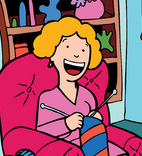If this is your first time using a knitting machine, it’s natural to feel intimidated by the intricate controls you never encountered with hand knitting.
Learning to master your knitting machine takes practice and patience. I have listed below 6 top tips and tricks that can help you shortcut your way to lovely machine-knitted garments.
Punch Cards
If you are using punch cards for machine knitting, try covering with tape the holes that you are not using to prevent mistimed punching.
Zippers
Pins are inconvenient to use when you’re running fabric through a knitting machine. Fabric glue is a better alternative when trying to hold a zipper in place while machine knitting. Before applying glue, make sure that the fabric is treated so it doesn’t shrink after washing. When the glue dries out completely, you can sew the zipper onto the fabric smoothly.
Marker Row
A marker row is useful when you are machine knitting down a long train of garment. They enable you to spot the row wherein you can hang a hem easily. To knit one marker row, pull out alternating needles to the farthest point and set the knitting machine carriage to “Part” or “Slip”. When knitting two marker rows, do the second row on the needles that are not on the previous row.
Stitch Gauge
If your rows are shorter than the number of per-inch stitches required by your knitting machine pattern, you can hang ribber weights or claw weights on your garment swatch to adapt your work to the exact number of rows.
Ribbing
Ribbing on a knitting machine keeps your stitches tight and firm. To do this, knit one circular row after the first vvvv row. After you set your needles, knit across to create a classic vvvvv row. Hang a cast on weights and comb then push the “part” button. After knitting one row, remove part and continue ribbing on the knitting machine.
Steaming and Blocking
Machine-knitted garments should be finished with a steaming process. Steam secures the stitches in place and produces a smoother fabric finish. Blocking can be done if you want to alter the dimensions or shape of your machine knitted garment. To block, pull the garment to the size you want as you steam. Not all garments are blocked but they all have to be steamed. Steam pieces one by one then stack them together and steam the seams.



